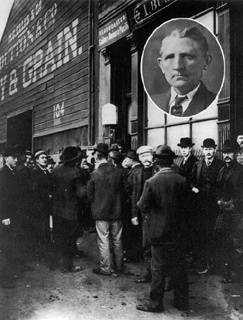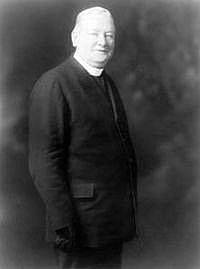1901 Labor War
Historical Essay
by Chris Carlsson
Workers gather in front of Audiffred Building during waterfront strike in 1901. Sailor's Union leader Andrew Furuseth (pictured in inset) had his offices through the door in the middle of the picture, upstairs at Mission & Steuart.
Photo: Bancroft Library, Berkeley, CA
In February a new formation, the City Front Federation, united the Sailor's Union of the Pacific, the longshoremen's unions, and the then-new Teamsters' Local 85. Teamsters' refusal to haul luggage from a non-union drayage firm caused the strike. Company after company locked out their workers who refused to haul the non-union luggage. Soon hundreds of locked out Teamsters found themselves among others who had already been on strike: restaurant cooks and waiters, bakers and bakery wagon drivers, metal polishers, and all fourteen unions of the Iron Trades Council, who were part of a national strike. City Front Federation voted to stage a waterfront strike, which began on July 30 and ran to October 2, 1901. Father Peter Yorke, an Irish Catholic priest in the Mission at St. Peter's, made a name for himself with many strongly pro-labor speeches and editorials (something he did mostly because so many of the strikers were Irish).
<iframe src="https://archive.org/embed/FatherPeterYorke" width="400" height="40" frameborder="0" webkitallowfullscreen="true" mozallowfullscreen="true" allowfullscreen></iframe>
Dramatized excerpt of Father Yorke speech, by Haight Ashbury Community Radio project, 1980.
An Employers' Association appeared two months after the founding of the City Front Federation. Association bylaws forbade any member from settling with a union without permission from the executive committee. The Employers' Association was the real power, pushing aside attempts to mediate and enlisting Mayor Phelan and his police force in their efforts. Their goal was to eliminate the unions altogether: “The vital principle involved in the present controversy is that of non-interference by the labor unions, or their representatives, with the conduct of the business of employers,” they announced. Strikebreakers were brought in and city police rode with them. The police were instructed to beat people but to make no arrests. Police behavior during this strike was a major factor in the fall Mayoral election which brought Eugene Schmitz, his patron Abe Ruef, and the Union Labor Party to power. After two months on strike the Governor intervened, bringing together the Teamsters and the representatives of the Drayman's Association, but excluding the Employer's Association. Within an hour an agreement was reached, and the Employers' Association disappeared in months, having lost on its “vital principle.” The strike toll: 5 dead, 300 injured. A gun battle on Kearny Street in broad daylight involved “special police,” (hired goons) and strikers.


